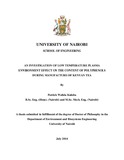| dc.description.abstract | Low Temperature Nitrogen Plasma (LTNP) was used to process green tealeaf to study its effect on the Polyphenol content in Made Tea. This was carried out using fresh green tea leaves that was collected on different days from the same tea farm. The green tealeaf was grown in the same climatic and soil conditions, cultivated under the same agronomical conditions and was of the same variety and maturity. It was handled from the farm up to the experimental site under similar conditions before it was worked on.
Using a Dielectric Barrier Discharge chamber to create the LTNP environment, seven samples of the green tealeaf were withered for various withering times ranging from 1 - 8 hours. The samples were macerated and dried before analyzing. The analyzed Made Tea samples indicated LTNP had an effect on Polyphenol content. Four constituent compounds forming the polyphenols were analyzed. From the various withering times, the highest polyphenol concentration of 78.56mg/g in Made Tea was achieved in one hour. The analyzed samples also indicated that polyphenol content in Made Tea was inversely proportional to the withering time.
To confirm the LTNP effect on the polyphenol content in the green tealeaf during withering, green tealeaf was also withered in non-plasma environments for comparison. The highest polyphenol content of 133.72mg/g was in a sample withered anaerobically in Nitrogen gas at room temperature and atmospheric pressure for eighteen hours. Another sample where green tea leaf was directly macerated and dried without any withering, no fermentation, had polyphenol content of 101.91mg/g of made tea. A green tealeaf sample withered aerobically, macerated, fermented and dried had polyphenol content of 21.23mg/g in Made Tea. Similarly as for LTNP withered green tealeaf, the polyphenol content also decreased with withering time. The analyzed samples also showed that withering green tea leaf in different conditions in overall resulted in different percentage composition of the constituent compounds and caffeine in the Made Tea. However in both cases the polyphenol content was higher than the currently processed teas available in the Kenyan market.
From the study, it was found that LTNP environment reduces polyphenol content in Made Tea during withering. It was also found that LTNP environment reduces polyphenols faster than
withering green tealeaf in nitrogen rich anaerobically. The decrease was caused by oxidation due to the presence of oxygen within the LTNP environment. The rate of reduction of polyphenols( ) with withering time (t) follows an exponential function and approaches a limiting minimum rate. Similarly decreases exponentially with respect to the remaining polyphenol content (Pc) in the green tealeaf. Thus indicating that, the kinetic order of the polyphenol reduction changes with withering time and obeys the mass action law in line with the theoretical prediction. The relationship of Pc and t follows an inverse proportionality relationship. Statistical analysis using MS-Excel of the experimental data showed that the mean rate of change of Pc in green tealeaf withered in LTNP was 7.539mg/h. The model prediction equations for in green tealeaf against t, against Pc and Pc against t were determined. These model predictive equations can be used for the design and processing of green tealeaf in order to obtain Made Tea with specific polyphenol contents. In consideration of the chemical composition of Made Tea including polyphenol content, a choice can be made from these withering methods to manufacture Made Tea with specific percentage composition of polyphenols. | en_US |

